The BoldSign mobile app is now available. Visitthis link for more details and give it a try!
The BoldSign mobile app is now available. Visitthis link for more details and give it a try!

Features
Explore the BoldSign features that make eSigning easier.





Latest Articles
7 Powerful Features to Enhance Your Signing Experience
What’s New in BoldSign: Recent Updates and Features April 2024
How to Electronically Sign Non-Disclosure Agreements